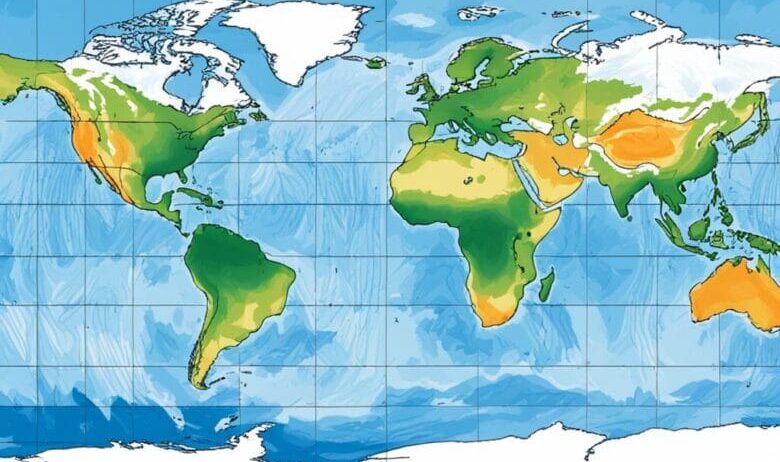Latitude plays a pivotal role in shaping the climate of different regions around the globe. Understanding how latitude interacts with climate factors can illuminate the environmental challenges faced by various ecosystems and societies. This comprehensive guide delves into the intricate connections between latitude and climate, exploring their implications.
To grasp how latitude affects climate, one must first understand what latitude signifies. Latitude refers to the distance of any point on Earth from the equator, measured in degrees. The equator, at 0 degrees latitude, serves as the baseline, while the poles reside at 90 degrees north and south. The position of a location relative to this baseline fundamentally influences its climate patterns, including temperature, precipitation, and seasonal variations.
Why Latitude Matters in Climate Patterns
Latitude is instrumental in determining the angle at which sunlight strikes the Earth’s surface. Regions near the equator receive sunlight more directly throughout the year, leading to consistently warm temperatures. In contrast, areas closer to the poles intersect sunlight at a more oblique angle, resulting in a diffuse distribution of solar energy and cooler temperatures.
This variation in solar energy reception gives rise to distinct climatic zones. The tropical zone, situated between the Tropic of Cancer and the Tropic of Capricorn, experiences high temperatures and substantial rainfall, fostering lush vegetation and diverse ecosystems. Conversely, the polar regions are characterized by extremely low temperatures and minimal precipitation, manifesting as icy tundra or barren landscapes.
Another crucial aspect of latitude’s influence on climate is its interaction with atmospheric circulation patterns. The Earth’s atmosphere is a dynamic system, and the distribution of solar energy affects wind patterns, ocean currents, and overall climate. As hot air rises near the equator, it creates low-pressure systems that draw in moist air and trigger precipitation. As this air travels poleward and cools down, it descends, leading to high-pressure systems and relatively arid conditions in certain mid-latitude regions.
Seasonal Variations: A Latitude Perspective
Latitude also dictates the severity and length of seasons experienced in different parts of the world. Regions located near the equator tend to have little seasonal variation, with temperatures remaining fairly consistent year-round. However, as one moves towards higher latitudes, seasonal extremes become more pronounced.
For instance, temperate zones, located between the tropical and polar latitudes, experience a mix of warm summers and cold winters. This seasonal fluctuation is primarily due to the tilt of the Earth’s axis, which causes varying angles of sunlight throughout the year. The summer solstice sees longer days and more direct sunlight, leading to warmer temperatures, while the winter solstice results in shorter days and cooler temperatures.
In contrast, polar regions endure long dark winters and brief summers. The extreme tilt of the Earth’s axis means that during winter months, these areas receive little to no sunlight, plunging them into frigid conditions. Conversely, during summer, the sun barely sets, allowing for continuous daylight and slightly warmer temperatures, though still quite cool compared to lower latitudes.
The Role of Ocean Currents and Geographic Features
While latitude is a primary determinant of climate, it does not operate in isolation. Ocean currents, which are heavily influenced by wind patterns and the Earth’s rotation, also play a vital role in moderating temperatures and precipitation patterns. For instance, the Gulf Stream carries warm water from the Gulf of Mexico along the eastern coast of North America and across the Atlantic Ocean, contributing to milder climates in regions that would otherwise be colder.
Furthermore, geographic features, such as mountain ranges and bodies of water, can exacerbate or mitigate the effects of latitude on climate. Mountains can create rain shadows, leading to arid conditions on one side and lush vegetation on the other. Similarly, proximity to large bodies of water can moderate temperatures, resulting in milder climates compared to areas further inland.
Implications of Latitude on Ecosystems and Human Habitation
The climatic variations driven by latitude have profound implications for ecosystems and human habitation. Tropical regions, rich in biodiversity, host an extensive array of flora and fauna, adapted to thrive in warm, humid conditions. On the flip side, polar regions are home to specially adapted species that can withstand extreme cold and reduced food availability.
Human activities are also influenced by latitude. Agriculture, for example, is highly dependent on climate conditions. Regions near the equator can grow a variety of crops year-round, while those in temperate zones often rely on distinct growing seasons. Moreover, migratory patterns of populations, urban planning, and energy consumption are often tailored according to the climatic realities dictated by latitude.
In conclusion, latitude is a critical determinant of climate, influencing temperature, precipitation, and seasonal variations across the globe. Understanding this relationship is crucial for addressing environmental challenges, conserving ecosystems, and planning sustainable communities. By recognizing the diverse climatic zones shaped by latitude, we can better appreciate and respond to the complex interplay of natural systems that define our planet.








